In the quest for a balanced and healthy lifestyle, flexibility often takes a backseat to more quantifiable fitness goals like strength, endurance, and weight loss. However, the significance of flexibility in enhancing overall health, performance, and well-being cannot be overlooked, as general mobility is considered the strongest foundation of healthy movement. Flexibility, or the ability of muscles and joints to move through an unrestricted range of motion, is critical in everyday activities and athletic performance. It aids in preventing injuries, reduces muscle soreness, improves posture, and facilitates efficient movement patterns.
Moreover, increased flexibility can lead to better blood circulation, reduced stress levels, and enhanced physical and mental relaxation. Despite its many benefits, flexibility is frequently overlooked in the typical fitness regimen. It is often brushed through quickly during a warm-up or cool-down but not as its own fitness entity.
Incorporating a stretching routine into your daily schedule is a straightforward and effective strategy to enhance your flexibility.1 Stretching exercises can be categorized into several types, the most common being static and dynamic stretches, each serving unique purposes and benefits. A well-designed stretching routine can accommodate individuals of all fitness levels, offering modifications and progressions to suit everyone, from beginners to elite athletes. Regular stretching also improves muscle recovery and growth by increasing blood flow to the muscles.2 Furthermore, dedicating time to stretch can provide a moment of mindfulness and mental clarity in today's fast-paced world. It offers a gentle break in the work day if you spend hours at a computer or work from home and struggle with nagging neck pain or back pain.
With consistency, patience, and the right approach, anyone can improve their flexibility, enhancing their physical performance and quality of life. This article dives deep into the plethora of stretching benefits for your mind and body and offers several exercises you can incorporate into your fitness routine or during work hours today.
{{mid-cta}}
Stretching Benefits for Your Mind and Body
Stretching exercises offer many physical and mental benefits that contribute to overall well-being. Although it may appear as only a physical exercise, stretching offers balance to your nervous system, a moment to be still, and an opportunity to become more in tune with how your body is feeling. This is particularly important for athletic performance and injury prevention. Let’s further dissect these benefits and see which ones may resonate with you.
Physical Benefits of Stretching
On a physical level, regular stretching enhances flexibility by increasing the elasticity of muscles and tendons, thereby improving the range of motion in joints.1 This increased flexibility aids in everyday movements while reducing the risk of injury during physical activities. Additionally, stretching promotes better posture by alleviating tightness in muscles that may pull the body out of alignment (i.e., hamstrings, quads, pectoral muscles, upper traps). By maintaining proper posture, individuals can prevent chronic pain and discomfort while improving overall body mechanics and providing pain-free movement.4
Mental Benefits of Stretching
Beyond its physical advantages, stretching has significant mental benefits as well. Engaging in a stretching routine promotes relaxation by releasing tension stored in muscles, which can help alleviate stress and encourage a sense of calm.5 Additionally, stretching increases blood flow to the muscles and brain, delivering oxygen and nutrients that can boost energy levels and reduce feelings of fatigue.2, 3 Using it as a strategy for meditation may help reduce stress and promote overall mental clarity.5
Emotional Benefits of Stretching
Stretching stimulates the release of endorphins, the body's natural feel-good hormones, which can elevate mood and create a sense of euphoria. The rhythmic and deliberate movements involved in stretching, such as those performed in a yoga practice, also encourage mindfulness, allowing individuals to focus on the present moment and tune into their body's sensations. By offering a moment of tranquility and emotional release, stretching is a powerful tool for managing stress, improving mood, and enhancing overall emotional resilience.6
<p class="pro-tip"><strong>Also Read: </strong><a href="anaerobic-exercise">14 Health Benefits of Anaerobic Exercise</a>.</p>
10 Full-Body Daily Stretching Exercises
Embarking on a full-body stretching routine offers a gateway to holistic wellness when adopted as a consistent, daily practice. This section delves into the intricacies of crafting a comprehensive stretching program that targets every major muscle group. By incorporating various exercises, from static holds to dynamic movements, individuals can experience the harmonious integration of physical, mental, and emotional well-being.
Whether as a standalone practice or integrated into a broader fitness routine, a full-body daily stretching routine holds the promise of enhancing overall health and vitality, offering a pathway towards improved athletic performance and a more balanced lifestyle. Try these stretches in the morning, before a cardio workout, during the workday, or as part of your gym routine. Hold the end position for at least 30 to 60 seconds for three to five rounds per side.
- Runner’s Stretch: Begin in a lunge position with your right foot forward, the right knee bent at a 90-degree angle, and the left leg extended straight back. Keep your hands on the ground or blocks for support. Slowly shift your weight forward, feeling a stretch in the hip flexors and quadriceps of the back leg. You will feel this in the left hip flexor and left thigh, as well as the glute or hamstring of the right leg. Repeat on the other side.
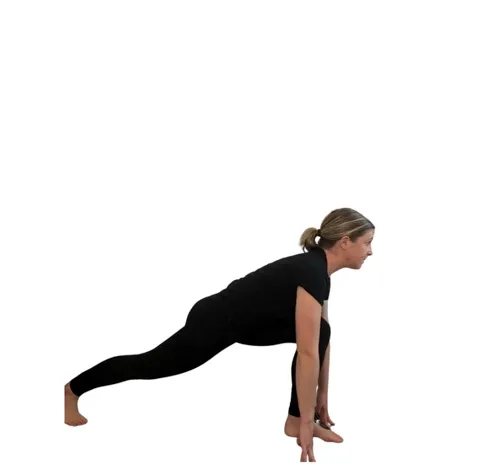
- Forward Fold: This one requires no equipment. Stand with feet shoulder-width apart. Slowly hinge forward at the hips, keeping your knees slightly bent. Allow your torso to hang over your legs, reaching towards your toes or the ground. Keep your back straight and lengthen your spine. You will feel the stretch in your hamstrings, lower back, and calves.

- Seated Back Twist: Sit on the floor with your legs extended in front of you. Bend the left knee and place the foot outside the right thigh. Twist your torso to the left, placing the right elbow on the outside of the left knee and using it to deepen the twist. Feel the stretch in your spine and the muscles along your back, and repeat on the other side.
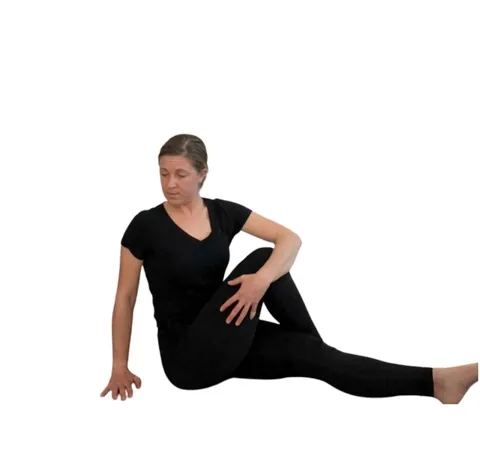
- Bound Angle: Sit on the floor or yoga mat with the soles of your feet together knees bent out to the sides. Hold onto your feet or ankles with your hands. Gently press your knees toward the ground while keeping your upper body and spine straight. Feel the stretch in your inner thighs and groin.
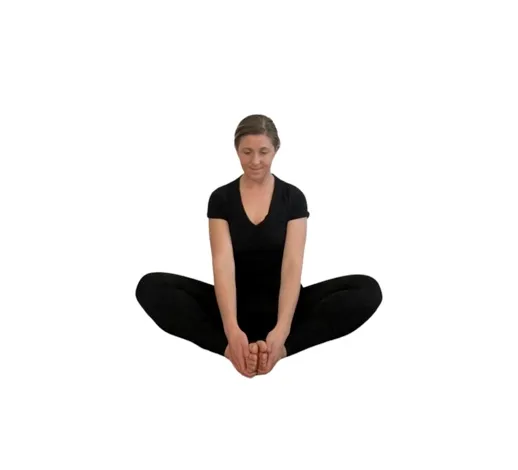
- Chest Stretch in Door: Stand facing an open doorway. Place one hand on each side of the doorway at shoulder height. Step forward with the right leg, leaning slightly into the doorway until you feel a big stretch in your chest and shoulders. Repeat on the other side. This exercise will help target your pecs and biceps, which become tight if you sit for long periods.
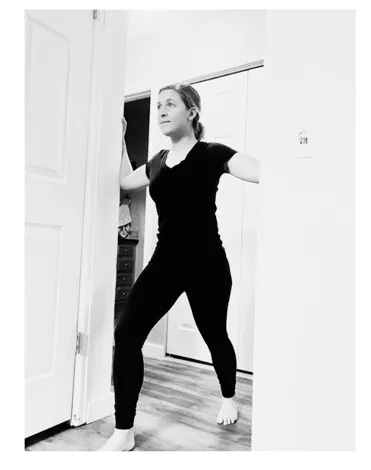
- Calf Stretch: Stand facing a wall with one foot forward and one foot back. Place your hands on the wall for support. Keep the back leg straight and the heel on the ground while bending the front knee. Lean forward slightly to deepen the stretch in the calf of the back leg. You can also bend your back knee to deepen the stretch of your deeper calf muscle—the soleus.

- Hamstring Stretch: Sit on the floor with one leg extended straight in front of you and the other leg bent with the foot resting against the inner thigh of the extended leg. Lean forward from the hips, keeping your spine straight and chest lifted as you reach toward the toes of the extended leg. This can feel intense, so ease into this position and take deep breaths to help ease the tension.
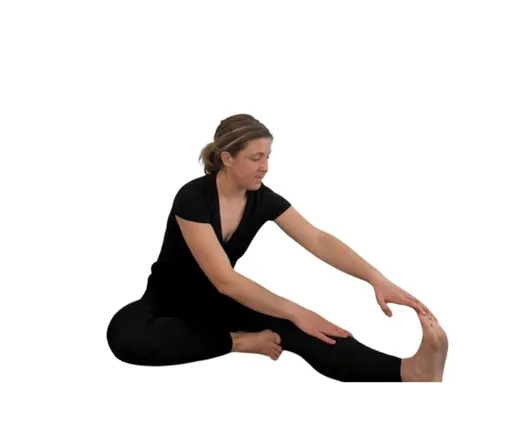
- Quadriceps Stretch: Stand tall with feet hip-width apart. Bend one knee and bring the foot towards the glutes, grasping the ankle with the corresponding hand. Keep the knees close together and the standing leg straight. Feel the stretch in the front of the thigh.

- Hip Flexor Stretch: Kneel on the floor with one knee bent at a 90-degree angle in front of you and the other knee on the ground behind you. Lean forward slightly, keeping your back straight, and tailbone tucked downward until you feel a stretch in the front of the hip of the back leg.

- Iliotibial Band Stretch: Stand with one leg crossed behind the other. Lean towards the side of the crossed leg, reaching overhead with the same arm as the crossed leg. Keep the opposite arm by your side for balance. Feel the stretch along the outside of the hip and thigh.

Using a CGM with Signos: Real-Time Data, Backed by AI
Signos pairs a real-time glucose biosensor with AI trained on tens of millions of data points to deliver personalized, science-backed guidance for weight management and health. See exactly how your body responds, and take action.
Learn how it works. Ready to get started? Join now.
<p class="pro-tip"><strong>Learn More: </strong><a href="aerobic-vs-anaerobic">The Benefits of Aerobic vs. Anaerobic Exercise and the Impact on Weight Loss</a>.</p>




.svg)









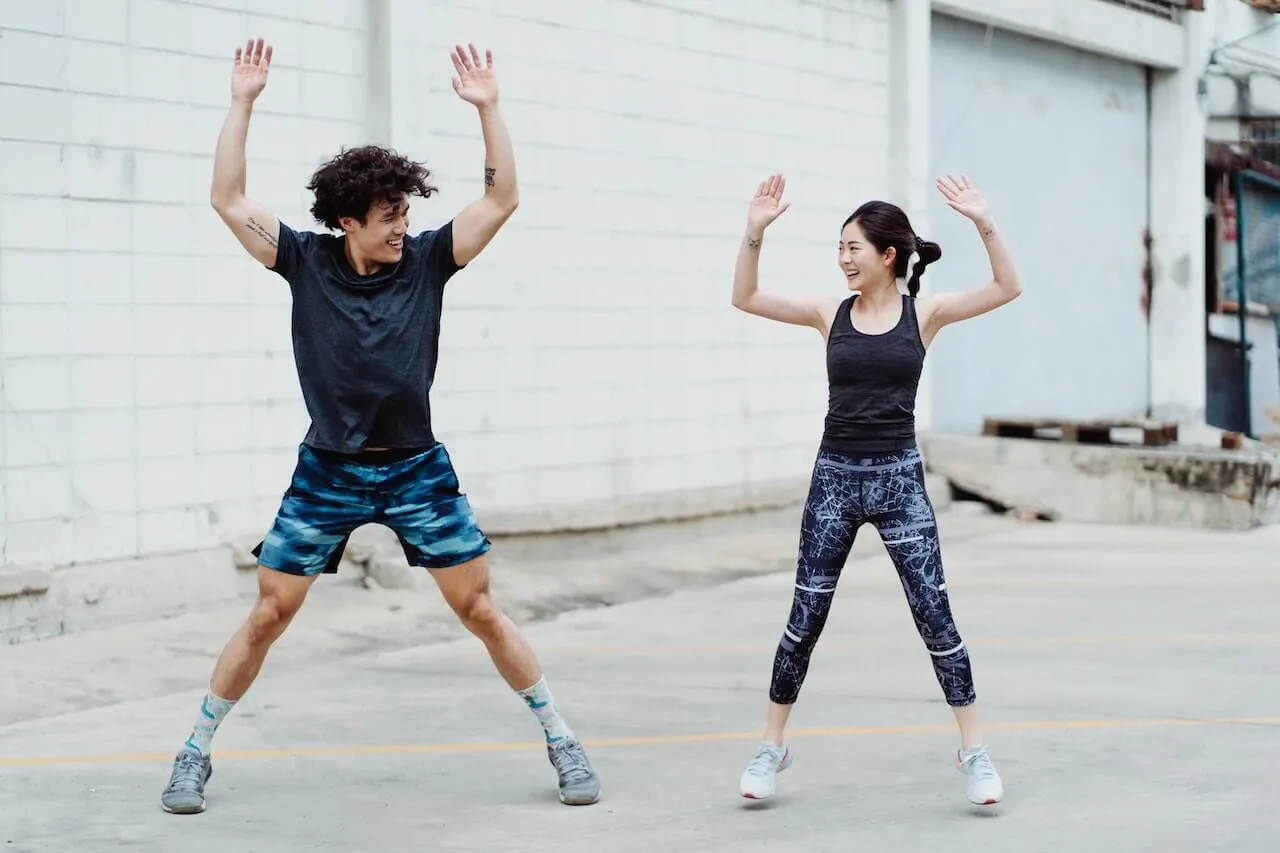
.svg)
.svg)
.svg)
.svg)
.svg)
.svg)
.svg)
